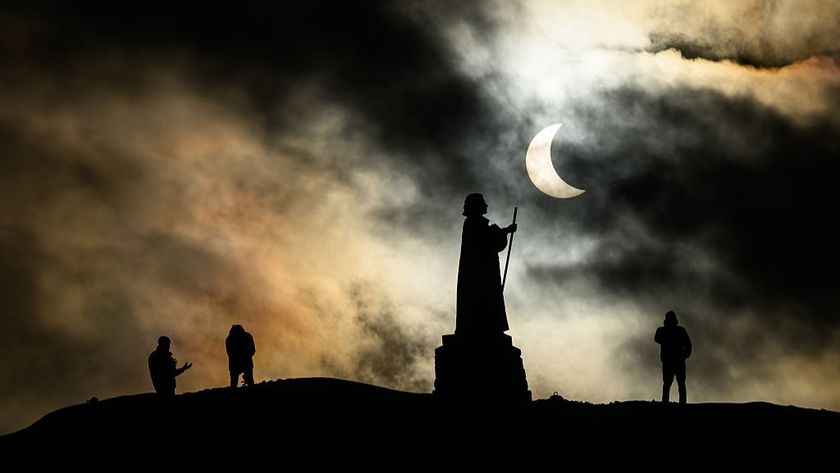
Though asteroids are viewed as stepping stones in NASA's manned march to Mars, sending humans to a space rock may actually be a bigger challenge than putting boots on the Red Planet.
Mars is farther away than any near-Earth asteroid that NASA would target, but this disadvantage may be outweighed by the greater knowledge scientists have gained of the Red Planet thanks to the many Mars missions that have launched over the years, experts say.
Further, mapping out an asteroid mission is nearly impossible at this point, since NASA does not yet know where it's going.
"There are still no good asteroid targets for such a mission, a necessary prerequisite for determining mission length and details such as the astronauts’ exposure to radiation and the consumables required," states a December 2012 report from the U.S. National Research Council (NRC). [How NASA Will Explore Asteroids (Gallery)]
The road to Mars
Landing astronauts on Mars has been the long-term goal of NASA's human spaceflight program for decades, but the agency's vision of how to get there was shaken up recently.
NASA had viewed the moon as a stepping stone, working to get humans to Earth's natural satellite by 2020 under a program called Constellation, which was initiated during the presidency of George W. Bush. But President Barack Obama cancelled Constellation in 2010, after an independent review panel found it to be significantly under-funded and behind schedule.
Get the Space.com Newsletter
Breaking space news, the latest updates on rocket launches, skywatching events and more!

The Obama administration instead directed NASA to send astronauts to a near-Earth asteroid by 2025, then on to the vicinity of Mars by the mid-2030s. The agency is developing a new crewed capsule called Orion and a huge rocket called the Space Launch System to make it all happen.
The new "asteroid-next" plan has not been enthusiastically embraced by NASA or the broader space community, the NRC report concluded.
"Despite isolated pockets of support for a human asteroid mission, the committee did not detect broad support for an asteroid mission inside NASA, in the nation as a whole or from the international community," write the authors of the report, which is called "NASA's Strategic Direction and the Need for a National Consensus."

A tough proposition
The NRC report was based on research, interviews, site visits and analysis conducted by a 12-member independent committee over the course of about five months in 2012.
One of the people the study team met with was Bill Gerstenmaier, NASA's associate administrator for human exploration and operations.
Gerstenmaier "talked about how NASA had discovered, in the two years that had elapsed by the time he was speaking to us, just how hard [a manned asteroid mission] was," committee member and space policy expert Marcia Smith said during a presentation with NASA's Future In-Space Operations working group on Jan. 30.
"He said in many respects, it's easier to go to Mars, because we know a lot about Mars," Smith added. "We know where it is, and we've done all these reconnaissance missions already, so we have a knowledge base from which to work in terms of sending humans, whereas no particular asteroid has been selected yet."
While sending astronauts to an asteroid has never been done before, unmanned probes have successfully rendezvoused with the objects in deep space multiple times.
For example, NASA's Dawn spacecraft orbited the protoplanet Vesta — the second-largest body in the main asteroid belt between Mars and Jupiter — for more than a year before departing to head to the belt's largest denizen, Ceres, last September. And in 2005, Japan's Hayabusa probe plucked some pieces off the near-Earth asteroid Itokawa, sending them back to Earth for analysis.
NASA plans to launch its own asteroid-sampling mission, called Osiris-Rex, in 2016. And two private companies — Planetary Resources and Deep Space Industries — intend to loft reconnaissance spacecraft over the next few years, kicking off an ambitious efforts to mine water, metals and other resources from asteroids.
Follow SPACE.com senior writer Mike Wall on Twitter @michaeldwall or SPACE.com @Spacedotcom. We're also on Facebook and Google+.
Join our Space Forums to keep talking space on the latest missions, night sky and more! And if you have a news tip, correction or comment, let us know at: community@space.com.

Michael Wall is a Senior Space Writer with Space.com and joined the team in 2010. He primarily covers exoplanets, spaceflight and military space, but has been known to dabble in the space art beat. His book about the search for alien life, "Out There," was published on Nov. 13, 2018. Before becoming a science writer, Michael worked as a herpetologist and wildlife biologist. He has a Ph.D. in evolutionary biology from the University of Sydney, Australia, a bachelor's degree from the University of Arizona, and a graduate certificate in science writing from the University of California, Santa Cruz. To find out what his latest project is, you can follow Michael on Twitter.









